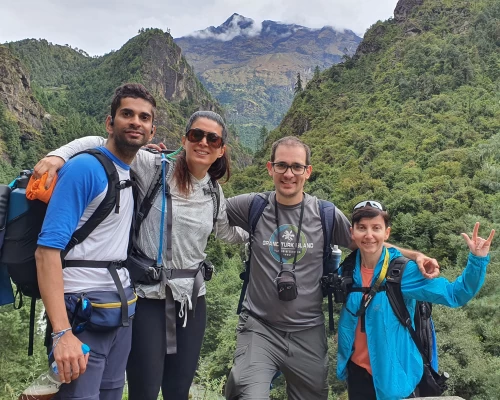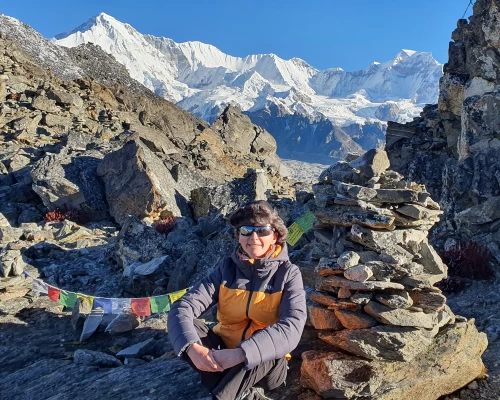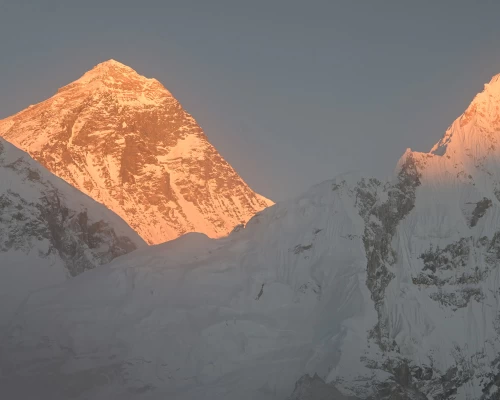Trek Grade

The route to approach Everest Base Camp via Gokyo Lake is graded as a moderately difficult level trek. Moreover, the trail leads to variations in altitude from Namche Bazaar (3440 m), Gokyo Ri (5357 m), and Everest base camp(5364 m) to the highest altitude in the whole EBC trek of 5644 m in Kalapathhar.
Moreover, the trek comprises a rugged path and steep terrains that are majorly covered with ascents and descents, making it challenging but rewarding.
Trek Duration
The total distance required to be covered in this trek route variation is about 137 km. Moreover, almost 6 to 8 hours of daily hiking, including the acclimatization days, is necessary to complete this trek.
The optimal days to conquer Everest base camp from Gokyo Lake will take about 18 days; about 9 km should be covered each day to complete this trek.
Best season for the trek

Everest base camp trekking is available all around for 12 months. However, the change of season plays a specific role in this trekking adventure. Out of all time, the months from March to May(spring season) and September to November (autumn season) are considered preferable times to get introduced to Everest base camp.
After the freezing cold, spring starts to bloom in the Khumbu region, spreading the sun shine brightly during the day. The days are milder, and nights are cooler, making this an ideal season for trekking. Moreover, the trees of the Everest region will come back to life with different shades of rhododendrons and the beauty of wildflowers.
Subsequently, during the fall season, the weather in the Everest region is pleasant as the foliage starts to turn golden and red. Moreover, wildlife like Lophophorus and Musk deer will be encountered in the Khumbu region, making your trek more exciting. Additionally, the festival season offers you an opportunity to blend with the traditions and culture of that region.
However, if you decide to do an Everest base camp trek via Gokyo Valley in the winter season, the trails, entire valleys, and mountains will be covered with snow like a blanket. The glaciers and lakes will also be frozen, so you will require crampons and ice axes while ascending.
Furthermore, if you are planning to make this trek during monsoon, you will play hide and seek with the mountains as the fog will cover all the visibility of the mountains in the blink of an eye and even clear the fog in an instant.
Difficulties and challenges

Even though the trekking trail is considered secure with no gremlins, while adventuring in the Himalayan ranges, you have to consider certain factors that can make the trek challenging.
Remote and difficult terrain
The Everest base camp trek is one of the most exciting mainstream trekking, but the trails are full of rocky paths, including stone stairways, suspension bridges, steep ascents, and descents. As the trek is to conquer the Himalayas, the steep ascents and descents make the distance to be covered shorter.
However, people with no prior trekking experience might find the trails difficult to walk on, which can be a huge challenge for them on this trek.
High altitude/ Altitude sickness
The trek will start from Lukla at an altitude of 2860 m, but as the trek progresses, the altitude elevates higher and finally concludes its inclination at 5644 m. So, trekkers like you have a higher probability of suffering from altitude sickness.
Long duration of hiking
Trekking is the composition of highly vigorous hiking that lasts for several days. Moreover, the route of Everest base camp through Gokyo Lake requires an average of 6 to 8 hours of hiking each day, which can be really exhaustive.
Remoteness
The route to Everest base camp has an unhinged remoteness to it. Even though the services and accommodations on the trek are conventional in comparison to other trekking trails in Nepal, in some teahouses, you may not get services of network reception, wifi, and hot showers, which can create difficulty for people who cannot adapt with the sudden change in circumstances.
Confusing route
Uncovering Everest base camp with the Gokyo route is relatively less crowded in comparison to the classic EBC trek. Moreover, without the guide, the trails from Gokyo Valley to descending Dzongla can be quite confusing and may leave you stranded for some time if you are making this journey without the guide.
Preparation for the trek

It is generally advised that trekking packing be kept as light as possible; nonetheless, the essentials should not be overlooked. If you are unsure about what to bring and what not to pack, you might consult this packing checklist.
Clothes
- Gloves, woolen hats
- Thermal layers
- T-shirts, shirts, both full or half-sleeves
- Trekking shorts and full pants
- Scarf or neck gaiters
- Windproof/waterproof trousers, heavy woolen trousers
- Fleece jacket
- Waterproof/ windproof shell jackets
- Heavy down jacket, woolen jacket
- Several pairs of undergarments
- Several pairs of socks
Shoes
- Comfortable hiking boots
- Sports or trainer shoes
- Sandals, crock, or slippers to use at the teahouses.
- Ankle Support
Personal hygiene and toiletries
- Toothpaste, toothbrush, facewash, Hand sanitizer
- Sunscreen, body lotion, and lip balm
- Soap, shampoo and conditioner
- Quick dry towels, toilet paper, Wet wipes, and face towel
- Deodorants
- Foot powder
- Personal medication (if any)
- Water purification solution or tablets
- Small first aid kit with all basic medications
Equipment
- Trekking poles, Duffle bag, packing sack
- Backpack/daypack
- Sleeping bag (four seasonal sleeping bags recommended)
- Binoculars, camera
- Headlamp with extra pair of batteries
- Power bank, solar charger
- Universal charging cord
- Reusable water bottles
- Thermos flask
- Card and board games
- Magazine, journal, pens
- Crampons
- Ice axe
Travel Insurance
You might not want to consider all the risks and unavoidable circumstances that may occur during the trek. Still, there is no surety that these mishaps occur. So, it is very essential to be insured with all these accidents and mishaps by travel insurance.
Because the regular 18-day Everest base camp trek via Gokyo Lake package does not include travel insurance, evidence of travel insurance is required when traveling with Explorer Adventure. Moreover, while taking travel insurance, you need to make sure that the policy you undertake covers all your medical expenses, evacuation costs, cancellation costs, and other expenses so that while trekking, you do not have to be constantly troubled with unnecessary thoughts and enjoy the journey.
Porters and Guides

Porters and guides are an inseparable part of your Everest base camp trek via Gokyo Lake. Guides are the mediators that will help you with the language barrier and navigate properly through the entire route. Moreover, they will provide you with prominent information about the places and culture.
Likewise, porters will help you carry the weight of your luggage so that you can easily travel the entire journey. Furthermore, the guides and porters that will accompany you with the climb are well-knowledgeable and experienced in their respective fields.
Guides are well trained in the simple medical first aid that will help you during altitude sickness or other medical issues and evacuation in case of emergency. Additionally, the porters that we provide you are strong and cheerful who can carry a maximum weight of about 15 to 25 kg. Moreover, two trekkers will be provided with one porter to carry the luggage.
Porters and guides are well taken care of by the company, which provides fair salary, medical insurance, travel allowance including meals on treks and climbs, and warm gear in winter for high and cold altitudes.
Information on AMS and precautionary measures

Acute mountain sickness is a common faced problem while making trips at higher altitude regions.
When the altitude increases, the air starts to get thinner, leading to a drop in the percentage of oxygen. As a result, people may feel uneasiness with shortness of breath, light headache, nausea, dizziness, lack of good sleep, and less appetite.
These are the common symptoms of altitude sickness, and you dont have to panic much. Usually, the symptoms of AMS get better in 1 to 3 days. You need to immediately report these symptoms to the guide so that they can help you cope with them.
Moreover, to avoid this sickness, you have to take an itinerary that has enough acclimatization hike so that your body can adapt to the higher altitude. Furthermore, it is very essential to be hydrated as dehydration is likely to cause altitude sickness. You have to intake enough water, at least 2 to 3 liters a day. Additionally, you need to have proper meals and sleep to energize yourself in the trek.
Another thing you need to remember is that trekking is not a competition. You need to walk at your own pace, catching your breath and stopping frequently. If you feel that you cannot make it further or feel the symptoms, it is okay to rest overnight and gradually take the trek. Your safety should be your first priority.
The next thing you can do is take the medications, and in case the symptoms do not fade away, visit the nearest health clinic.
Are any preparations required beforehand for the trek?
Since the Everest base camp trek via Gokyo Lake is a demanding trekking adventure with some taxing difficulties, it is better if you are prepared beforehand for the adventure.
Despite the fact that prior high-altitude experience is not required, those experiences can come in handy during this trek. So, you can try going for hikes at a higher altitude. The trek demands strength and endurance, so it is highly recommended that you try some strength and cardiovascular exercises. Moreover, you should be mentally prepared for long hiking durations to make your trek more familiar and comfortable.
Are permits necessary?

When it comes to trekking to Everest base camp, you need to obtain some documents. Though there are other different paperwork you need to do prior to EBC trekking, obtaining the permits is one crucial documentation process.
The Everest base camp lies under the Sagarmatha National Park area. Hence, it is essential to acquire a Sagarmatha National Park permit to enter the area. You can acquire this permit either at Monjo at the entry gate or at the Nepal Tourism Board office.
Sagarmatha National Park permit cost
Foreigners except SAARC nationals= NPR 3000 per person.
SAARC nationals=NPR 1500 per person.
Nepalese citizen=NPR 100 per person
All these costs are excluded from VAT. Moreover, children under the age of 10 are allowed to enter the area for free.
Since you will reach your destination by hiking through Pasang Lhamu Municipality in the Khumbu region, the local government of the region has newly introduced Khumbu Pasang Lahmu Rural Municipality Permit.
Khumbu Pasang Lahmu Rural Municipality Permit cost
For the first four weeks = USD 20 per person/ week
After exceeding four weeks = USD 25 per person /week.
Everest Base Camp Trek via Gokyo Lake cost
If you want to be introduced to Everest with some route modifications accompanied by Explorer Adventure, you've come to the right spot because we provide a competitive price for the journey. The trek will cost a total of $1500 USD per participant. Doesn't that sound reasonable?
You may also like:



















.webp)



